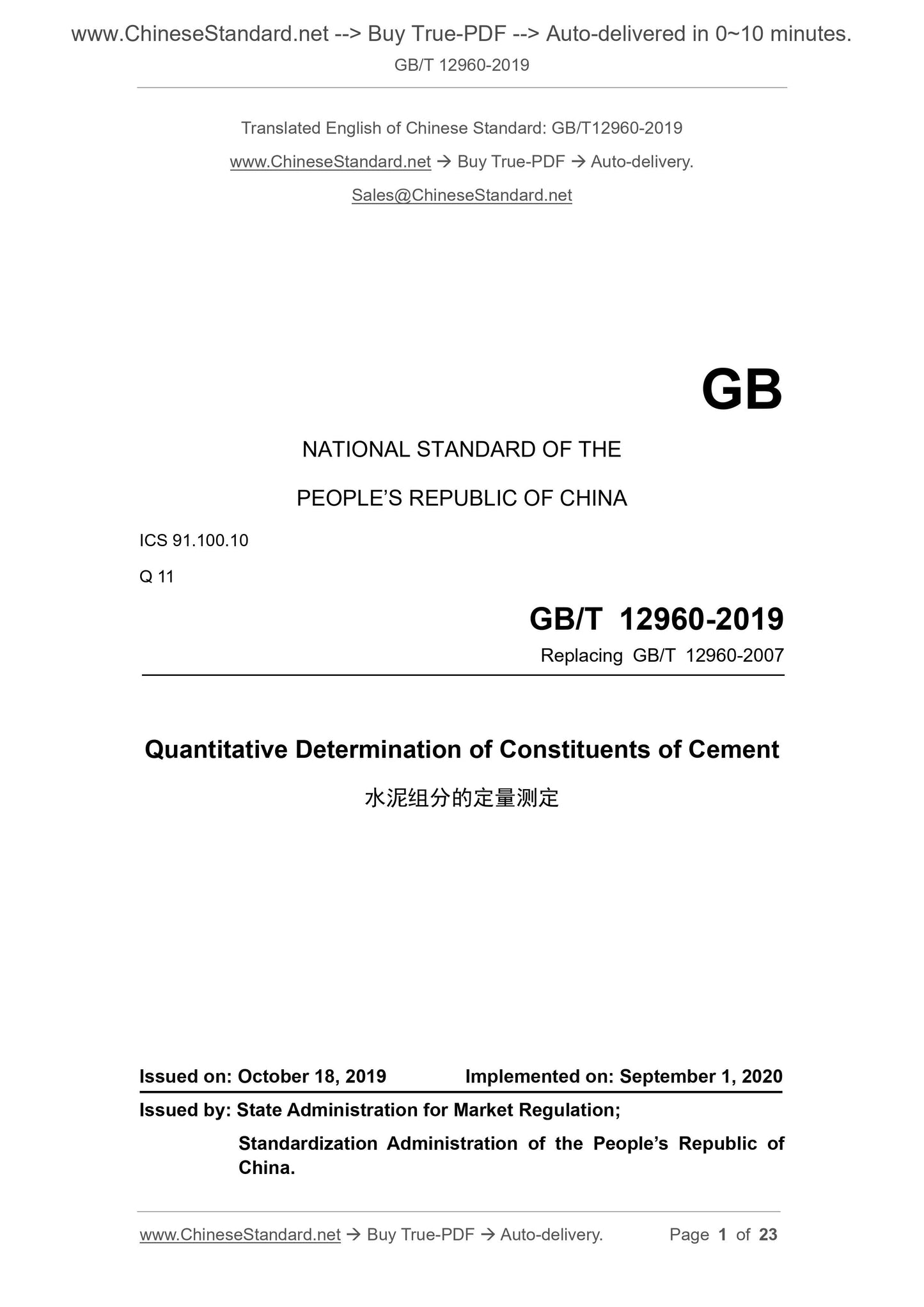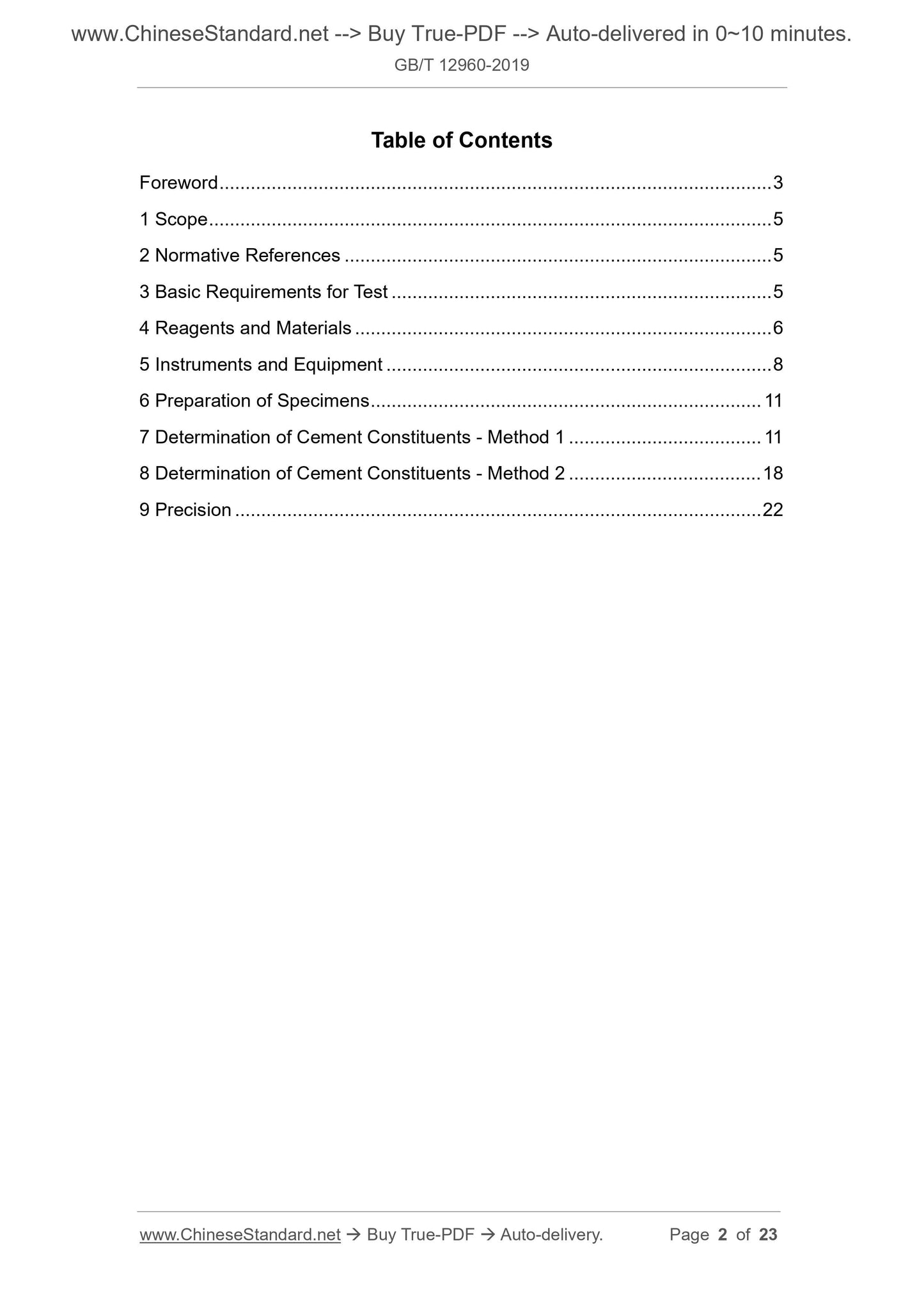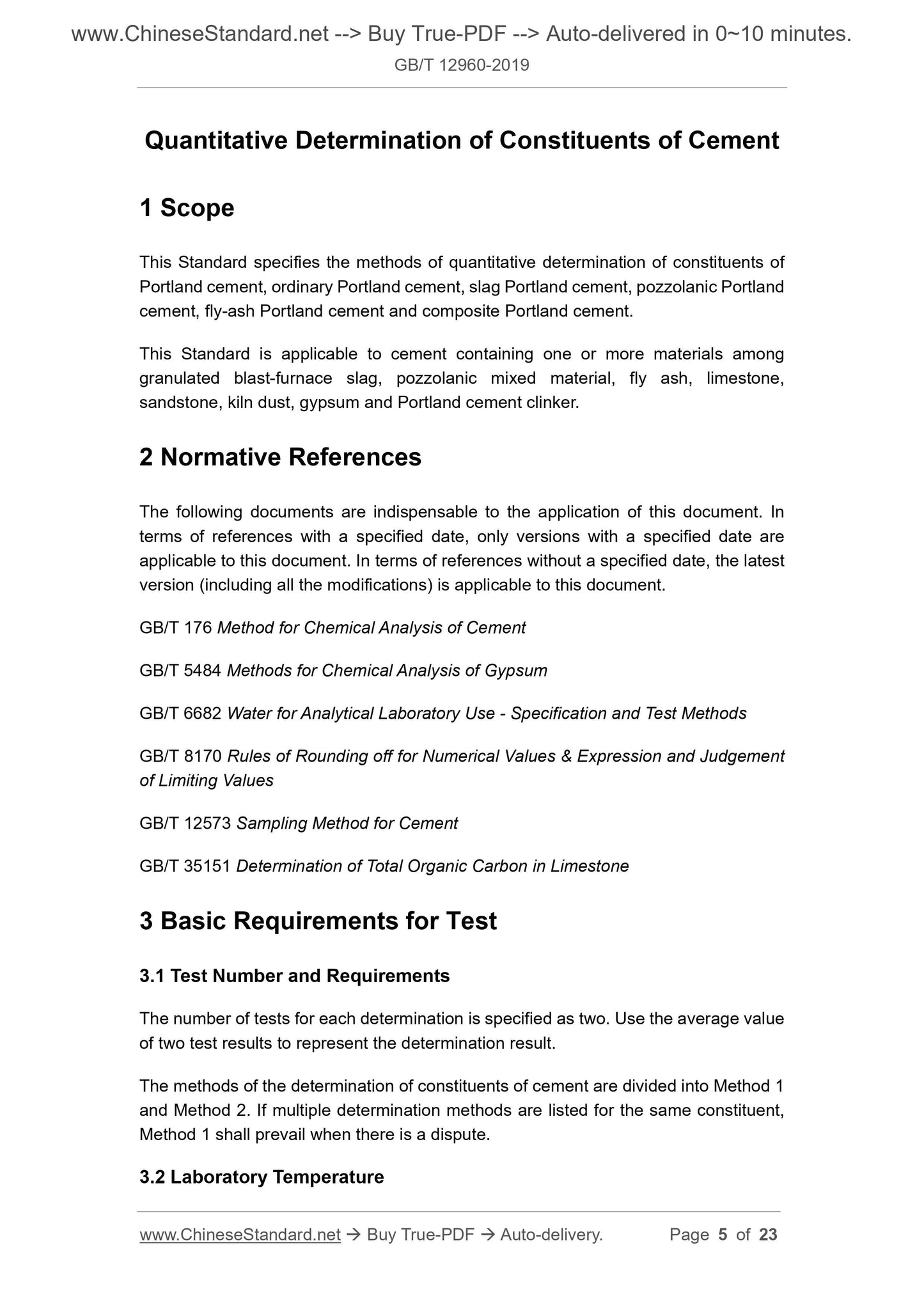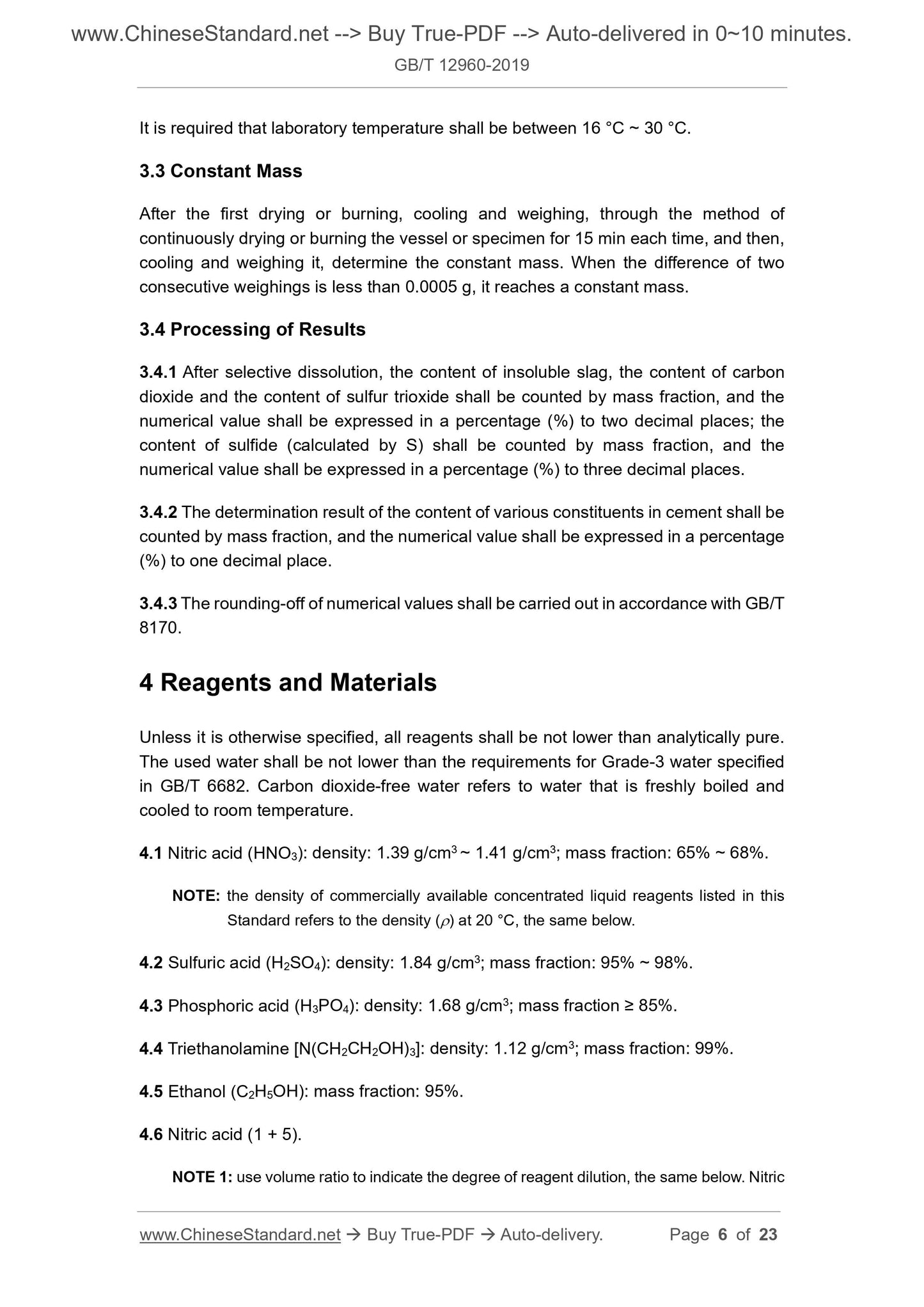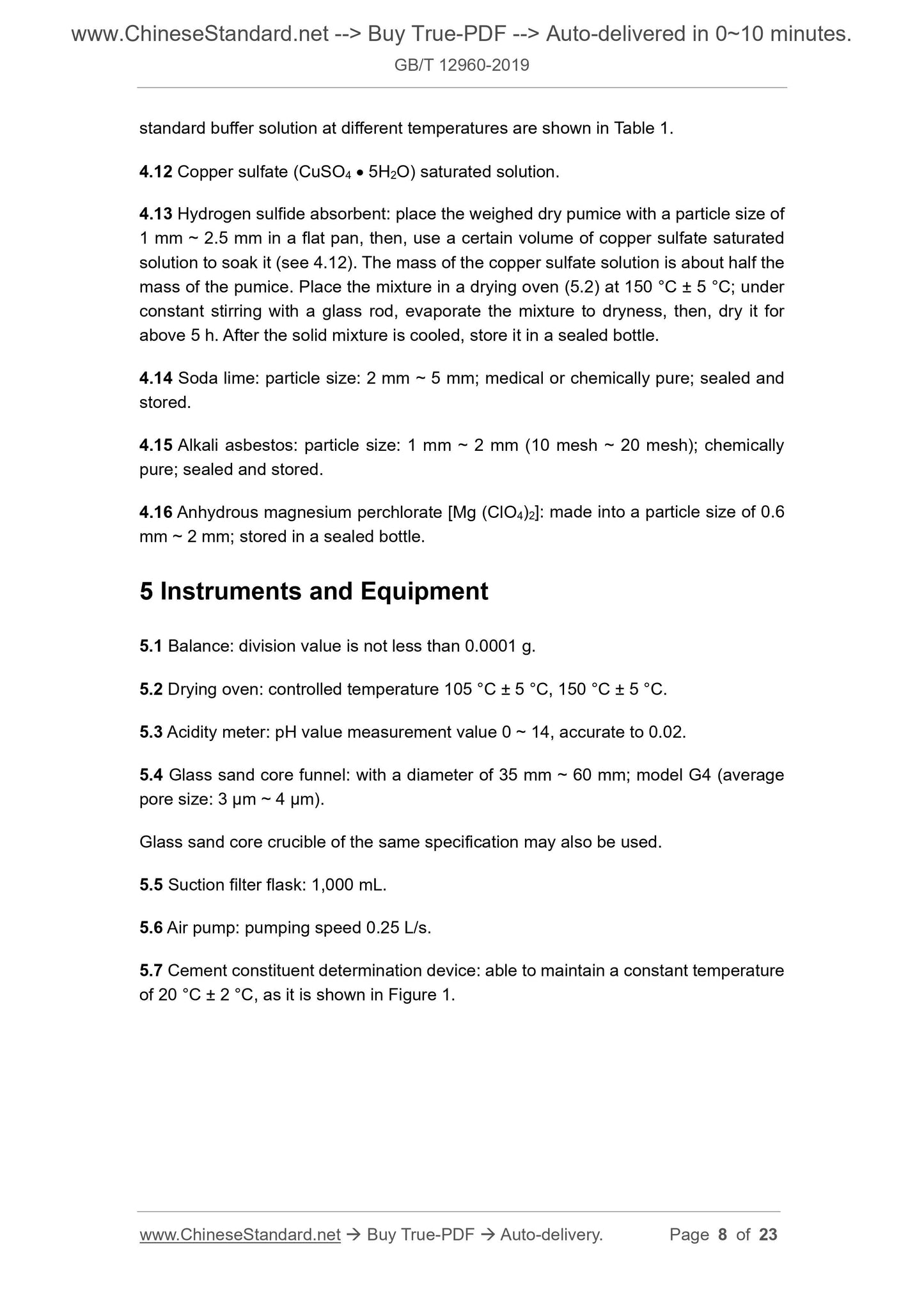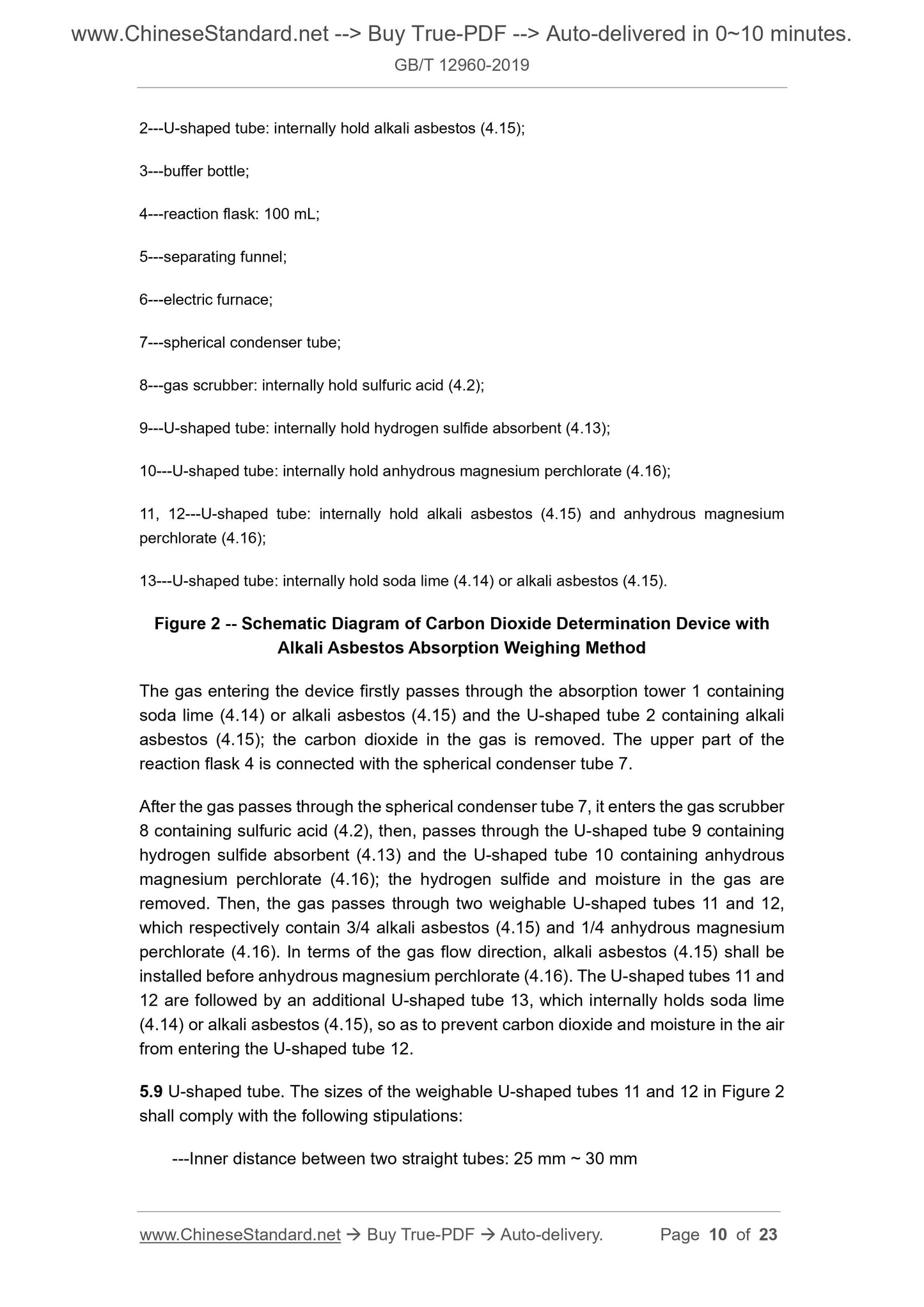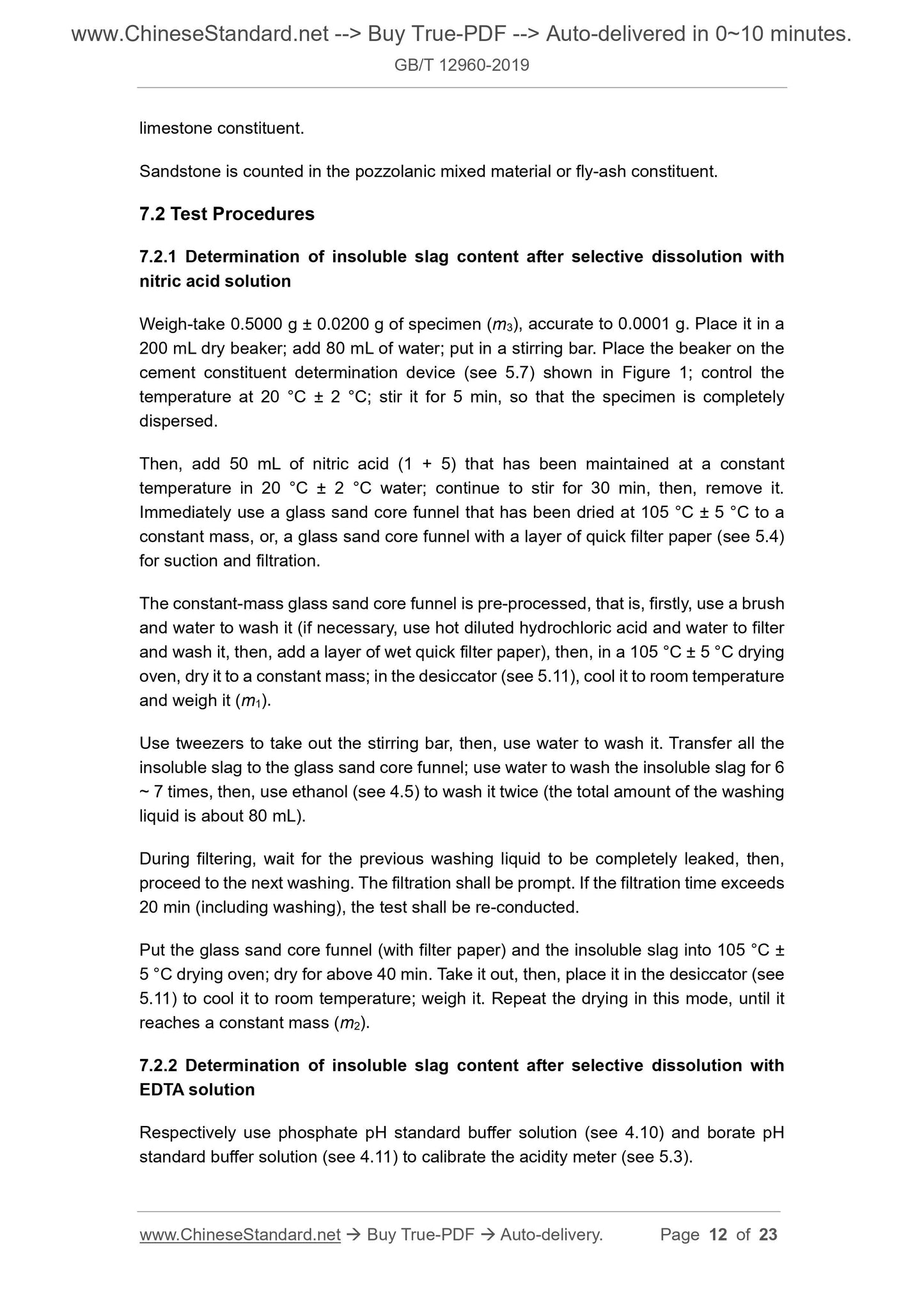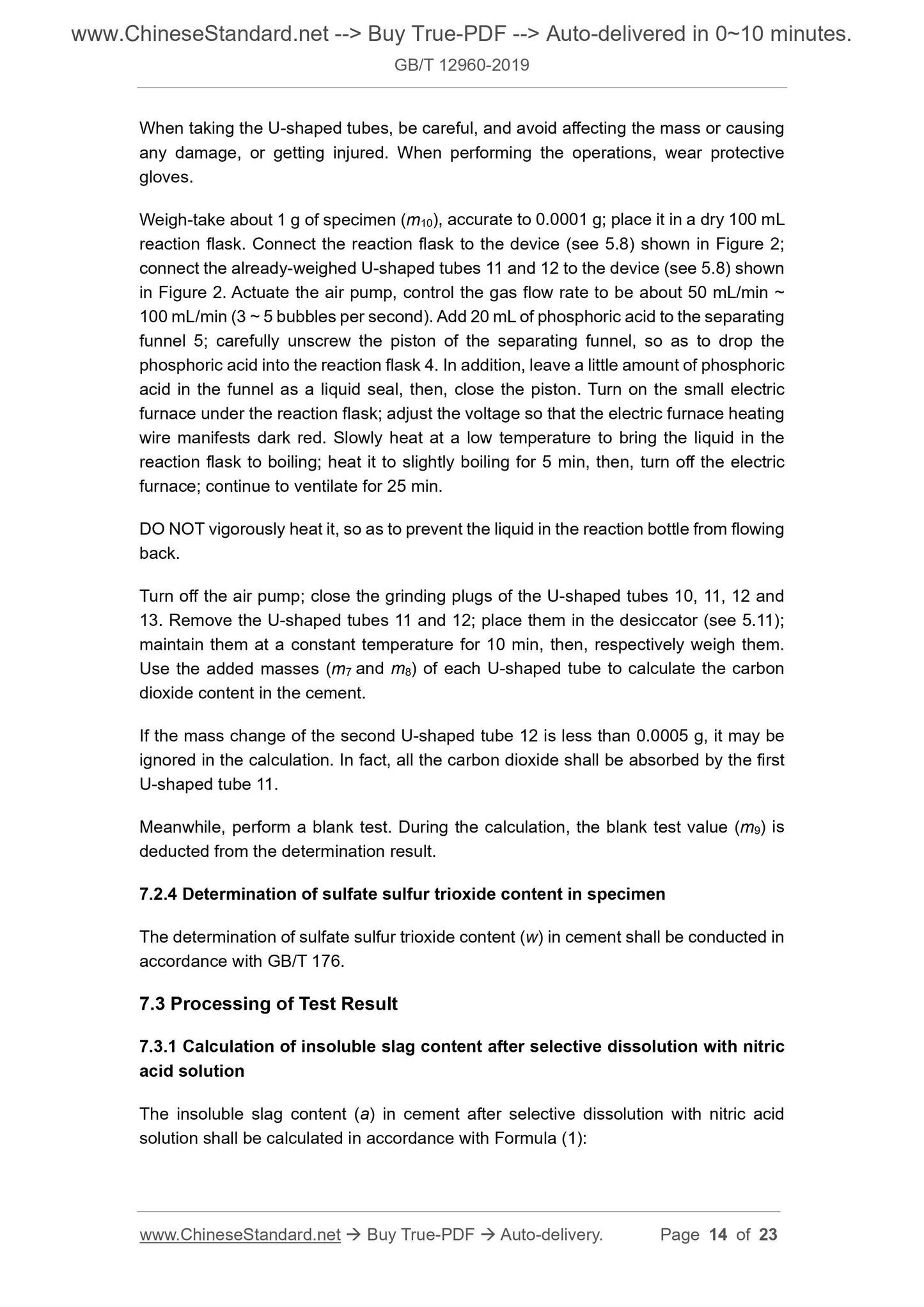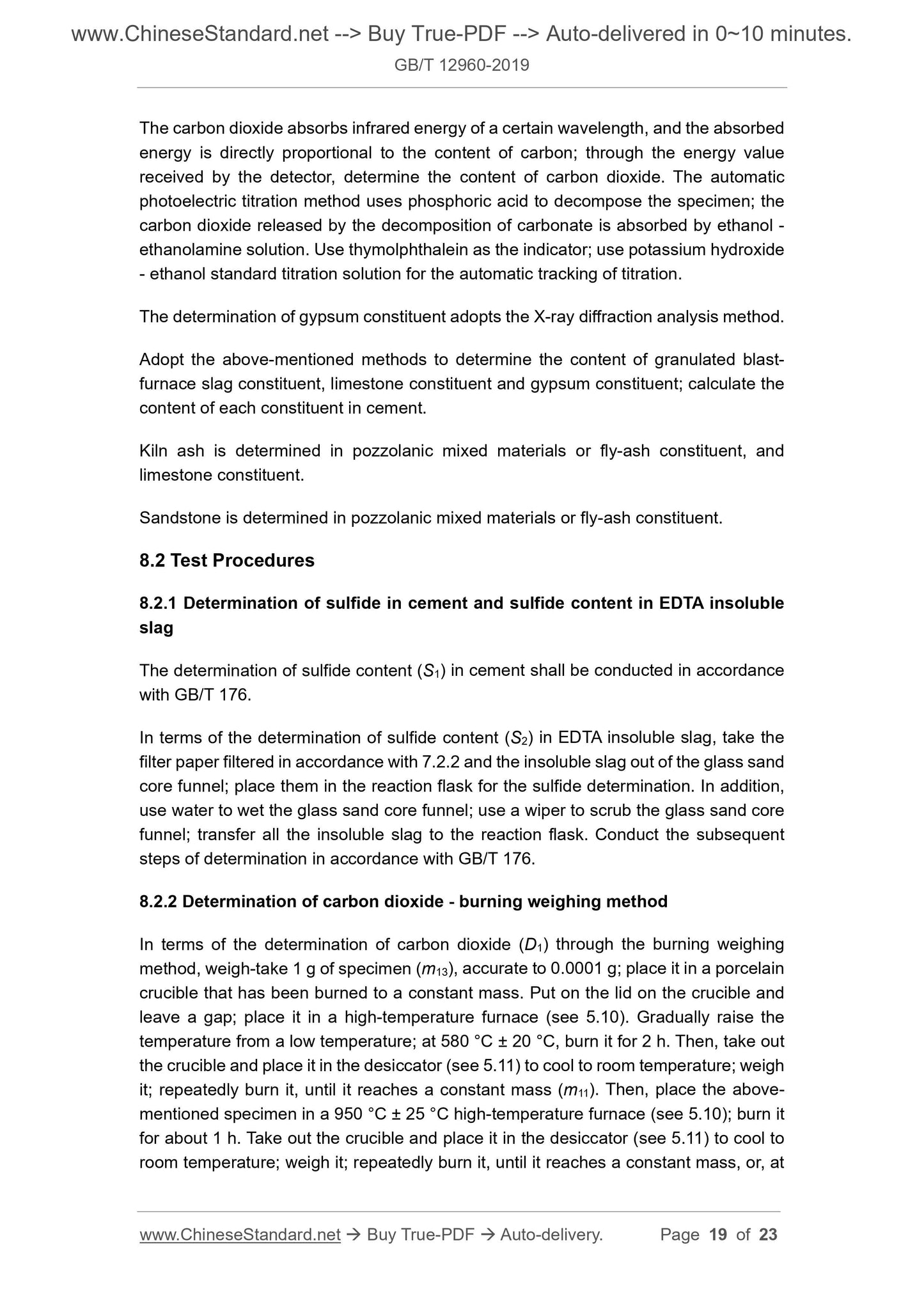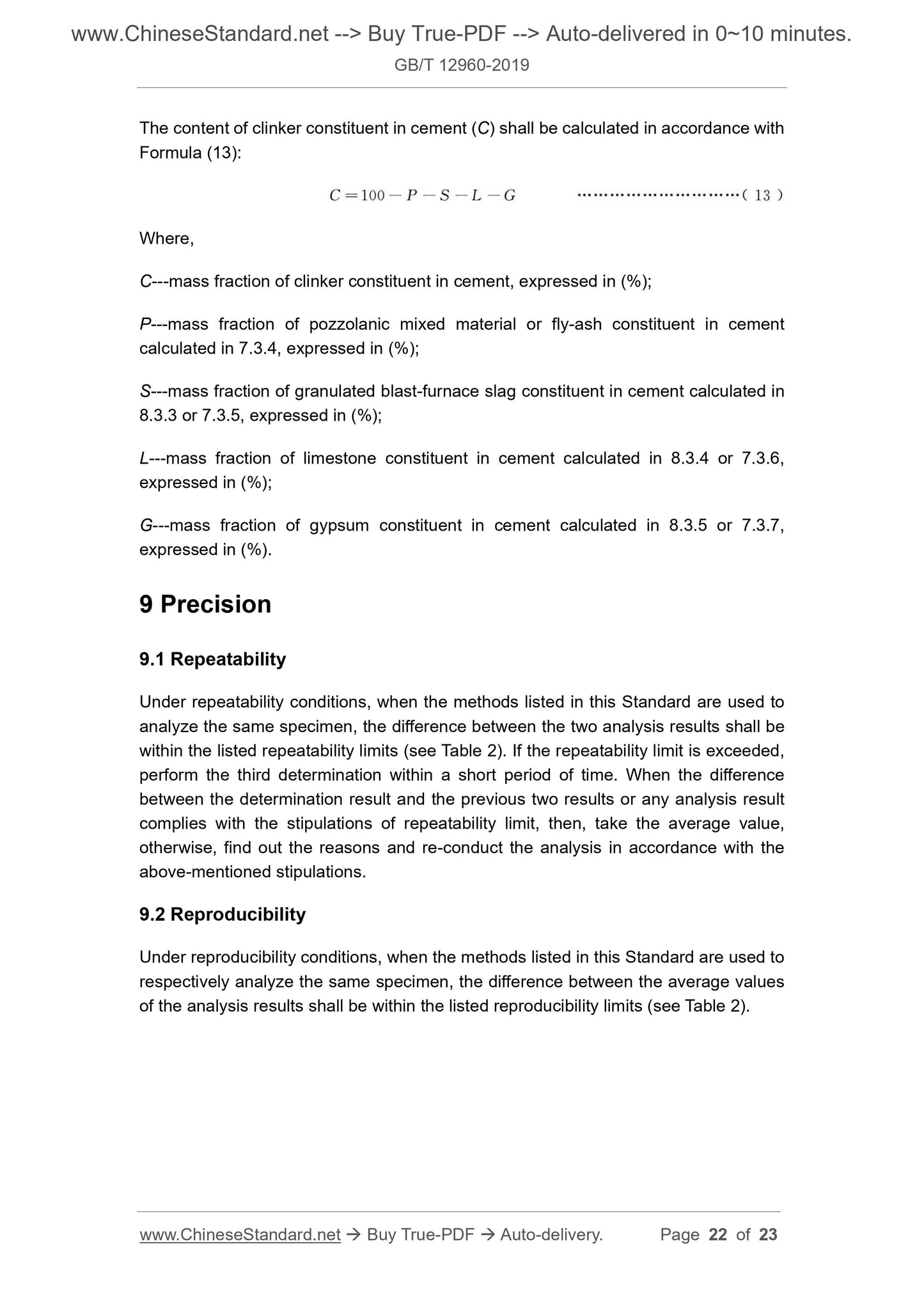1
/
of
10
PayPal, credit cards. Download editable-PDF and invoice in 1 second!
GB/T 12960-2019 English PDF (GBT12960-2019)
GB/T 12960-2019 English PDF (GBT12960-2019)
Regular price
$210.00 USD
Regular price
Sale price
$210.00 USD
Unit price
/
per
Shipping calculated at checkout.
Couldn't load pickup availability
Delivery: 3 seconds. Download true-PDF + Invoice.
Get QUOTATION in 1-minute: Click GB/T 12960-2019
Historical versions: GB/T 12960-2019
Preview True-PDF (Reload/Scroll if blank)
GB/T 12960-2019: Quantitative determination of constituents of cement
GB/T 12960-2019
GB
NATIONAL STANDARD OF THE
PEOPLE’S REPUBLIC OF CHINA
ICS 91.100.10
Q 11
Replacing GB/T 12960-2007
Quantitative Determination of Constituents of Cement
ISSUED ON: OCTOBER 18, 2019
IMPLEMENTED ON: SEPTEMBER 1, 2020
Issued by: State Administration for Market Regulation;
Standardization Administration of the People’s Republic of
China.
Table of Contents
Foreword ... 3
1 Scope ... 5
2 Normative References ... 5
3 Basic Requirements for Test ... 5
4 Reagents and Materials ... 6
5 Instruments and Equipment ... 8
6 Preparation of Specimens ... 11
7 Determination of Cement Constituents - Method 1 ... 11
8 Determination of Cement Constituents - Method 2 ... 18
9 Precision ... 22
Quantitative Determination of Constituents of Cement
1 Scope
This Standard specifies the methods of quantitative determination of constituents of
Portland cement, ordinary Portland cement, slag Portland cement, pozzolanic Portland
cement, fly-ash Portland cement and composite Portland cement.
This Standard is applicable to cement containing one or more materials among
granulated blast-furnace slag, pozzolanic mixed material, fly ash, limestone,
sandstone, kiln dust, gypsum and Portland cement clinker.
2 Normative References
The following documents are indispensable to the application of this document. In
terms of references with a specified date, only versions with a specified date are
applicable to this document. In terms of references without a specified date, the latest
version (including all the modifications) is applicable to this document.
GB/T 176 Method for Chemical Analysis of Cement
GB/T 5484 Methods for Chemical Analysis of Gypsum
GB/T 6682 Water for Analytical Laboratory Use - Specification and Test Methods
GB/T 8170 Rules of Rounding off for Numerical Values and Expression and Judgement
of Limiting Values
GB/T 12573 Sampling Method for Cement
GB/T 35151 Determination of Total Organic Carbon in Limestone
3 Basic Requirements for Test
3.1 Test Number and Requirements
The number of tests for each determination is specified as two. Use the average value
of two test results to represent the determination result.
The methods of the determination of constituents of cement are divided into Method 1
and Method 2. If multiple determination methods are listed for the same constituent,
Method 1 shall prevail when there is a dispute.
3.2 Laboratory Temperature
It is required that laboratory temperature shall be between 16 °C ~ 30 °C.
3.3 Constant Mass
After the first drying or burning, cooling and weighing, through the method of
continuously drying or burning the vessel or specimen for 15 min each time, and then,
cooling and weighing it, determine the constant mass. When the difference of two
consecutive weighings is less than 0.0005 g, it reaches a constant mass.
3.4 Processing of Results
3.4.1 After selective dissolution, the content of insoluble slag, the content of carbon
dioxide and the content of sulfur trioxide shall be counted by mass fraction, and the
numerical value shall be expressed in a percentage (%) to two decimal places; the
content of sulfide (calculated by S) shall be counted by mass fraction, and the
numerical value shall be expressed in a percentage (%) to three decimal places.
3.4.2 The determination result of the content of various constituents in cement shall be
counted by mass fraction, and the numerical value shall be expressed in a percentage
(%) to one decimal place.
3.4.3 The rounding-off of numerical values shall be carried out in accordance with GB/T
8170.
4 Reagents and Materials
Unless it is otherwise specified, all reagents shall be not lower than analytically pure.
The used water shall be not lower than the requirements for Grade-3 water specified
in GB/T 6682. Carbon dioxide-free water refers to water that is freshly boiled and
cooled to room temperature.
4.1 Nitric acid (HNO3): density: 1.39 g/cm3 ~ 1.41 g/cm3; mass fraction: 65% ~ 68%.
NOTE: the density of commercially available concentrated liquid reagents listed in this
Standard refers to the density () at 20 °C, the same below.
4.2 Sulfuric acid (H2SO4): density: 1.84 g/cm3; mass fraction: 95% ~ 98%.
4.3 Phosphoric acid (H3PO4): density: 1.68 g/cm3; mass fraction ≥ 85%.
4.4 Triethanolamine [N(CH2CH2OH)3]: density: 1.12 g/cm3; mass fraction: 99%.
4.5 Ethanol (C2H5OH): mass fraction: 95%.
4.6 Nitric acid (1 + 5).
NOTE 1: use volume ratio to indicate the degree of reagent dilution, the same below. Nitric
standard buffer solution at different temperatures are shown in Table 1.
4.12 Copper sulfate (CuSO4 5H2O) saturated solution.
4.13 Hydrogen sulfide absorbent: place the weighed dry pumice with a particle size of
1 mm ~ 2.5 mm in a flat pan, then, use a certain volume of copper sulfate saturated
solution to soak it (see 4.12). The mass of the copper sulfate solution is about half the
mass of the pumice. Place the mixture in a drying oven (5.2) at 150 °C ± 5 °C; under
constant stirring with a glass rod, evaporate the mixture to dryness, then, dry it for
above 5 h. After the solid mixture is cooled, store it in a sealed bottle.
4.14 Soda lime: particle size: 2 mm ~ 5 mm; medical or chemically pure; sealed and
stored.
4.15 Alkali asbestos: particle size: 1 mm ~ 2 mm (10 mesh ~ 20 mesh); chemically
pure; sealed and stored.
4.16 Anhydrous magnesium perchlorate [Mg (ClO4)2]: made into a particle size of 0.6
mm ~ 2 mm; stored in a sealed bottle.
5 Instruments and Equipment
5.1 Balance: division value is not less than 0.0001 g.
5.2 Drying oven: controlled temperature 105 °C ± 5 °C, 150 °C ± 5 °C.
5.3 Acidity meter: pH value measurement value 0 ~ 14, accurate to 0.02.
5.4 Glass sand core funnel: with a diameter of 35 mm ~ 60 mm; model G4 (average
pore size: 3 μm ~ 4 μm).
Glass sand core crucible of the same specification may also be used.
5.5 Suction filter flask: 1,000 mL.
5.6 Air pump: pumping speed 0.25 L/s.
5.7 Cement constituent determination device: able to maintain a constant temperature
of 20 °C ± 2 °C, as it is shown in Figure 1.
2---U-shaped tube: internally hold alkali asbestos (4.15);
3---buffer bottle;
4---reaction flask: 100 mL;
5---separating funnel;
6---electric furnace;
7---spherical condenser tube;
8---gas scrubber: internally hold sulfuric acid (4.2);
9---U-shaped tube: internally hold hydrogen sulfide absorbent (4.13);
10---U-shaped tube: internally hold anhydrous magnesium perchlorate (4.16);
11, 12---U-shaped tube: internally hold alkali asbestos (4.15) and anhydrous magnesium
perchlorate (4.16);
13---U-shaped tube: internally hold soda lime (4.14) or alkali asbestos (4.15).
Figure 2 -- Schematic Diagram of Carbon Dioxide Determination Device with
Alkali Asbestos Absorption Weighing Method
The gas entering the device firstly passes through the absorption tower 1 containing
soda lime (4.14) or alkali asbestos (4.15) and the U-shaped tube 2 containing alkali
asbestos (4.15); the carbon dioxide in the gas is removed. The upper part of the
reaction flask 4 is connected with the spherical condenser tube 7.
After the gas passes through the spherical condenser tube 7, it enters the gas scrubber
8 containing sulfuric acid (4.2), then, passes through the U-shaped tube 9 containing
hydrogen sulfide absorbent (4.13) and the U-shaped tube 10 containing anhydrous
magnesium perchlorate (4.16); the hydrogen sulfide and moisture in the gas ...
Get QUOTATION in 1-minute: Click GB/T 12960-2019
Historical versions: GB/T 12960-2019
Preview True-PDF (Reload/Scroll if blank)
GB/T 12960-2019: Quantitative determination of constituents of cement
GB/T 12960-2019
GB
NATIONAL STANDARD OF THE
PEOPLE’S REPUBLIC OF CHINA
ICS 91.100.10
Q 11
Replacing GB/T 12960-2007
Quantitative Determination of Constituents of Cement
ISSUED ON: OCTOBER 18, 2019
IMPLEMENTED ON: SEPTEMBER 1, 2020
Issued by: State Administration for Market Regulation;
Standardization Administration of the People’s Republic of
China.
Table of Contents
Foreword ... 3
1 Scope ... 5
2 Normative References ... 5
3 Basic Requirements for Test ... 5
4 Reagents and Materials ... 6
5 Instruments and Equipment ... 8
6 Preparation of Specimens ... 11
7 Determination of Cement Constituents - Method 1 ... 11
8 Determination of Cement Constituents - Method 2 ... 18
9 Precision ... 22
Quantitative Determination of Constituents of Cement
1 Scope
This Standard specifies the methods of quantitative determination of constituents of
Portland cement, ordinary Portland cement, slag Portland cement, pozzolanic Portland
cement, fly-ash Portland cement and composite Portland cement.
This Standard is applicable to cement containing one or more materials among
granulated blast-furnace slag, pozzolanic mixed material, fly ash, limestone,
sandstone, kiln dust, gypsum and Portland cement clinker.
2 Normative References
The following documents are indispensable to the application of this document. In
terms of references with a specified date, only versions with a specified date are
applicable to this document. In terms of references without a specified date, the latest
version (including all the modifications) is applicable to this document.
GB/T 176 Method for Chemical Analysis of Cement
GB/T 5484 Methods for Chemical Analysis of Gypsum
GB/T 6682 Water for Analytical Laboratory Use - Specification and Test Methods
GB/T 8170 Rules of Rounding off for Numerical Values and Expression and Judgement
of Limiting Values
GB/T 12573 Sampling Method for Cement
GB/T 35151 Determination of Total Organic Carbon in Limestone
3 Basic Requirements for Test
3.1 Test Number and Requirements
The number of tests for each determination is specified as two. Use the average value
of two test results to represent the determination result.
The methods of the determination of constituents of cement are divided into Method 1
and Method 2. If multiple determination methods are listed for the same constituent,
Method 1 shall prevail when there is a dispute.
3.2 Laboratory Temperature
It is required that laboratory temperature shall be between 16 °C ~ 30 °C.
3.3 Constant Mass
After the first drying or burning, cooling and weighing, through the method of
continuously drying or burning the vessel or specimen for 15 min each time, and then,
cooling and weighing it, determine the constant mass. When the difference of two
consecutive weighings is less than 0.0005 g, it reaches a constant mass.
3.4 Processing of Results
3.4.1 After selective dissolution, the content of insoluble slag, the content of carbon
dioxide and the content of sulfur trioxide shall be counted by mass fraction, and the
numerical value shall be expressed in a percentage (%) to two decimal places; the
content of sulfide (calculated by S) shall be counted by mass fraction, and the
numerical value shall be expressed in a percentage (%) to three decimal places.
3.4.2 The determination result of the content of various constituents in cement shall be
counted by mass fraction, and the numerical value shall be expressed in a percentage
(%) to one decimal place.
3.4.3 The rounding-off of numerical values shall be carried out in accordance with GB/T
8170.
4 Reagents and Materials
Unless it is otherwise specified, all reagents shall be not lower than analytically pure.
The used water shall be not lower than the requirements for Grade-3 water specified
in GB/T 6682. Carbon dioxide-free water refers to water that is freshly boiled and
cooled to room temperature.
4.1 Nitric acid (HNO3): density: 1.39 g/cm3 ~ 1.41 g/cm3; mass fraction: 65% ~ 68%.
NOTE: the density of commercially available concentrated liquid reagents listed in this
Standard refers to the density () at 20 °C, the same below.
4.2 Sulfuric acid (H2SO4): density: 1.84 g/cm3; mass fraction: 95% ~ 98%.
4.3 Phosphoric acid (H3PO4): density: 1.68 g/cm3; mass fraction ≥ 85%.
4.4 Triethanolamine [N(CH2CH2OH)3]: density: 1.12 g/cm3; mass fraction: 99%.
4.5 Ethanol (C2H5OH): mass fraction: 95%.
4.6 Nitric acid (1 + 5).
NOTE 1: use volume ratio to indicate the degree of reagent dilution, the same below. Nitric
standard buffer solution at different temperatures are shown in Table 1.
4.12 Copper sulfate (CuSO4 5H2O) saturated solution.
4.13 Hydrogen sulfide absorbent: place the weighed dry pumice with a particle size of
1 mm ~ 2.5 mm in a flat pan, then, use a certain volume of copper sulfate saturated
solution to soak it (see 4.12). The mass of the copper sulfate solution is about half the
mass of the pumice. Place the mixture in a drying oven (5.2) at 150 °C ± 5 °C; under
constant stirring with a glass rod, evaporate the mixture to dryness, then, dry it for
above 5 h. After the solid mixture is cooled, store it in a sealed bottle.
4.14 Soda lime: particle size: 2 mm ~ 5 mm; medical or chemically pure; sealed and
stored.
4.15 Alkali asbestos: particle size: 1 mm ~ 2 mm (10 mesh ~ 20 mesh); chemically
pure; sealed and stored.
4.16 Anhydrous magnesium perchlorate [Mg (ClO4)2]: made into a particle size of 0.6
mm ~ 2 mm; stored in a sealed bottle.
5 Instruments and Equipment
5.1 Balance: division value is not less than 0.0001 g.
5.2 Drying oven: controlled temperature 105 °C ± 5 °C, 150 °C ± 5 °C.
5.3 Acidity meter: pH value measurement value 0 ~ 14, accurate to 0.02.
5.4 Glass sand core funnel: with a diameter of 35 mm ~ 60 mm; model G4 (average
pore size: 3 μm ~ 4 μm).
Glass sand core crucible of the same specification may also be used.
5.5 Suction filter flask: 1,000 mL.
5.6 Air pump: pumping speed 0.25 L/s.
5.7 Cement constituent determination device: able to maintain a constant temperature
of 20 °C ± 2 °C, as it is shown in Figure 1.
2---U-shaped tube: internally hold alkali asbestos (4.15);
3---buffer bottle;
4---reaction flask: 100 mL;
5---separating funnel;
6---electric furnace;
7---spherical condenser tube;
8---gas scrubber: internally hold sulfuric acid (4.2);
9---U-shaped tube: internally hold hydrogen sulfide absorbent (4.13);
10---U-shaped tube: internally hold anhydrous magnesium perchlorate (4.16);
11, 12---U-shaped tube: internally hold alkali asbestos (4.15) and anhydrous magnesium
perchlorate (4.16);
13---U-shaped tube: internally hold soda lime (4.14) or alkali asbestos (4.15).
Figure 2 -- Schematic Diagram of Carbon Dioxide Determination Device with
Alkali Asbestos Absorption Weighing Method
The gas entering the device firstly passes through the absorption tower 1 containing
soda lime (4.14) or alkali asbestos (4.15) and the U-shaped tube 2 containing alkali
asbestos (4.15); the carbon dioxide in the gas is removed. The upper part of the
reaction flask 4 is connected with the spherical condenser tube 7.
After the gas passes through the spherical condenser tube 7, it enters the gas scrubber
8 containing sulfuric acid (4.2), then, passes through the U-shaped tube 9 containing
hydrogen sulfide absorbent (4.13) and the U-shaped tube 10 containing anhydrous
magnesium perchlorate (4.16); the hydrogen sulfide and moisture in the gas ...
Share
